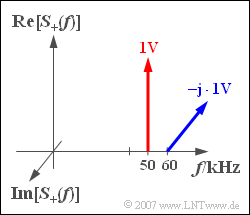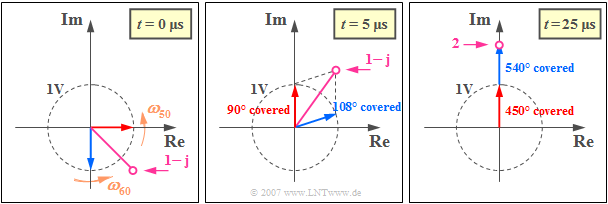Difference between revisions of "Aufgaben:Exercise 4.4Z: Pointer Diagram for SSB-AM"
| Line 18: | Line 18: | ||
| − | |||
| − | |||
| − | |||
| − | |||
''Hints:'' | ''Hints:'' | ||
*This exercise belongs to the chapter [[Signal_Representation/Analytical_Signal_and_Its_Spectral_Function|Analytical Signal and its Spectral Function]]. | *This exercise belongs to the chapter [[Signal_Representation/Analytical_Signal_and_Its_Spectral_Function|Analytical Signal and its Spectral Function]]. | ||
| − | *You can check your solution with the interaction module [[Applets: | + | *You can check your solution with the interaction module [[Applets:Physical_Signal_%26_Analytic_Signal|Physical and Analytical Signal]]. |
| − | |||
| − | |||
| − | |||
| − | |||
| − | |||
| − | |||
| − | |||
Revision as of 16:23, 7 May 2021
The analytical signal s+(t) with the line spectrum
- S+(f)=1V⋅δ(f−f50)−j⋅1V⋅δ(f−f60)
is to be considered. Here f50 and f60 are abbreviations for the frequencies 50 kHz and 60 kHz, respectively.
This analytical signal could occur, for example, with the Single Sideband Amplitude Modulation (SSB-AM) of a sinusoidal message signal (Frequenz fN=10 kHz) with a cosinusoidal carrier signal (fT=50 kHz) , whereby only the upper sideband is transmitted ⇒   Upper Sideband Modulation.
However, the analytical signal could also result from a (Lower Sideband Modulation) of the same sinusoidal signal if a sinusoidal carrier with frequency fT=60 kHz is used.
Hints:
- This exercise belongs to the chapter Analytical Signal and its Spectral Function.
- You can check your solution with the interaction module Physical and Analytical Signal.
Questions
Solution
(1) The analytical signal is generally:
- s+(t)=1V⋅ejω50t−j⋅1V⋅ejω60t.
At time t=0 the complex exponential functions each take the value 1 and one obtains (see left graph):
- Re[s+(t=0)]=+1 V_,
- Im[s+(t=0)]=−1 V_.
(2) For the analytical signal it can also be written:
- s+(t)=1V⋅cos(ω50t)+j⋅1V⋅sin(ω50t)−j⋅1V⋅cos(ω60t)+1V⋅sin(ω60t).
The real part of this describes the actual, physical signal:
- s(t)=1V⋅cos(ω50t)+1V⋅sin(ω60t).
Correct is the proposed solution 3:
- Considering the 50 kHz-Cosinussignals cosine signal alone, the first zero crossing would occur at t1=T0/4 , i.e. after 5 µs, where T0=1/f50=20 µs denotes the period duration of this signal.
- The sinusoidal signal with the frequency 60 kHz is positive during the entire first half-wave (0...8.33 µs) .
- Due to the plus sign, the first zero crossing of s(t) ⇒ t1>5 µs is delayed.
- The middle graph shows the analytical signal at time t=T0/4, when the red carrier would have its zero crossing.
- The zero crossing of the violet cumulative pointer only occurs when it points in the direction of the imaginary axis. Then s(t1)=Re[s+(t1)]=0.
(3) The maximum value of |s+(t)| is reached when both pointers point in the same direction. The amount of the sum pointer is then equal to the sum of the two individual pointers; i.e. 2 V_.
This case is reached for the first time when the faster pointer with angular velocity ω60 has caught up its "lag" of 90∘(π/2) with the slower pointer (ω50) :
- ω60⋅t2−ω50⋅t2=π2⇒t2=π/22π(f60−f50)=14⋅(f60−f50)=25µs_.
- At this point, the two pointers have made 5/4 bzw. 6/4 revolutions respectively and both point in the direction of the imaginary axis (see right graph).
- The actual, physical signal s(t) – i.e. the real part of s+(t) – is therefore zero at this moment.
(4) The condition for |s+(t3)|=0 is that there is a phase offset of 180∘ between the two equally long pointers so that they cancel each other out.
- This further means that the faster pointer has rotated 3π/2 further than the 50 kHz-component.
- Analogous to the sample solution of sub-task (3) , the following therefore applies:
- t3=3π/22π(f60−f50)=75µs_.

